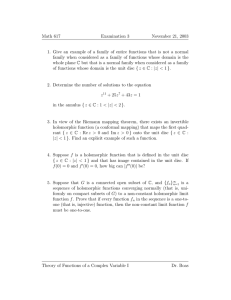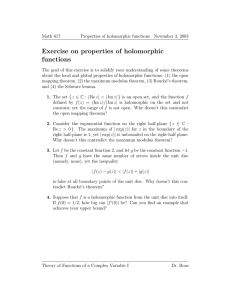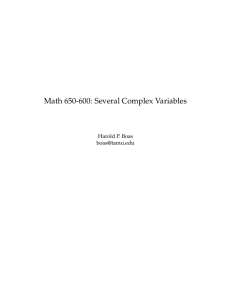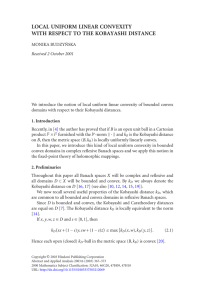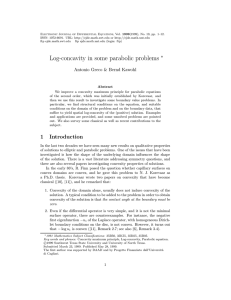Math 650-600: Several Complex Variables Harold P. Boas
advertisement
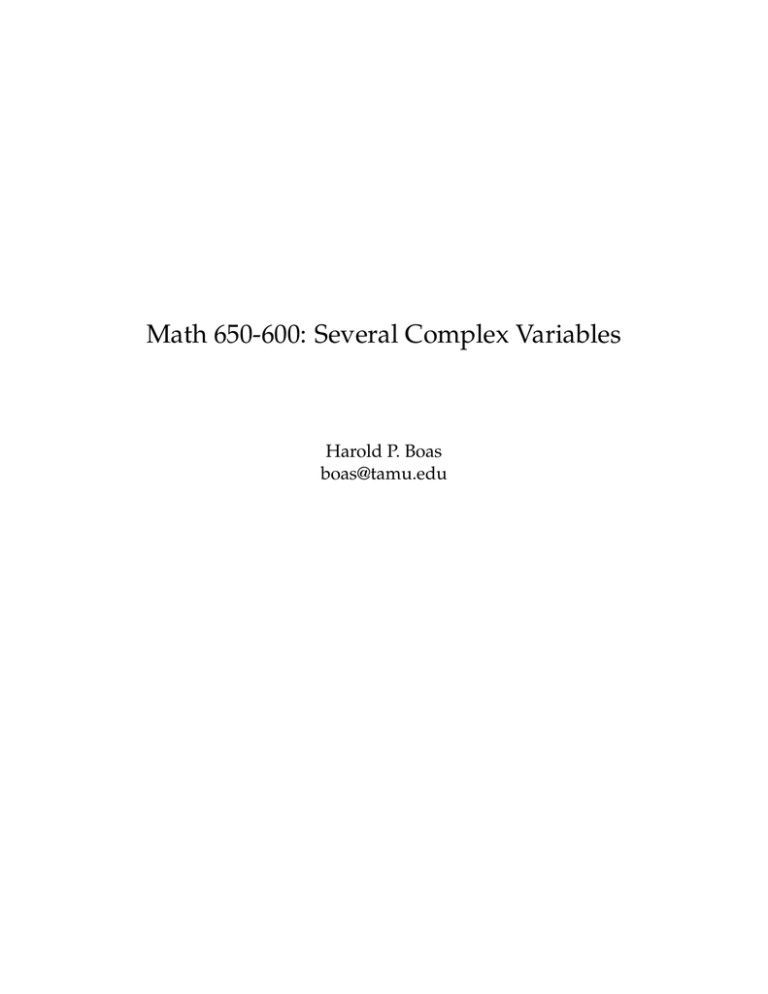
Math 650-600: Several Complex Variables
Harold P. Boas
boas@tamu.edu
Exercises on convexity
A domain Ω in Cn is convex with respect to a set F of real-valued functions on Ω if K ⊂⊂ Ω ⇒
bF ⊂⊂ Ω.
K
Exercise. Let F be the set of moduli of holomorphic polynomials of degree 1. Show that Ω is
convex with respect to F if and only if Ω is convex in the ordinary geometric sense.
Exercise. Make a Venn diagram showing the relationships among the following concepts:
• convexity
• holomorphic convexity
• polynomial convexity
• weak linear convexity
Math 650-600
February 24, 2005 — slide #2
Equivalence theorem
b denotes the holomorphically convex
Notation: Ω is a domain in Cn with boundary bΩ, and K
hull of K with respect to Ω.
Theorem. The following properties are equivalent.
1. Ω is a domain of holomorphy in the sense that for every point of bΩ there exists a holomorphic function on Ω that “does not extend across the boundary near p”.
b bΩ).
2. If K ⊂⊂ Ω, then dist(K, bΩ) = dist( K,
b ⊂⊂ Ω; in other words, Ω is holomorphically convex.
3. If K ⊂⊂ Ω, then K
4. Ω is a domain of holomorphy in the sense that there exists a holomorphic function on Ω
that “does not extend across any part of the boundary”.
The implications (2) ⇒ (3) and (4) ⇒ (1) are easy. We will check (3) ⇒ (4) and (1) ⇒ (2).
Math 650-600
February 24, 2005 — slide #3
Proof that (1) implies (2)
b bΩ) is strictly smaller than dist(K, bΩ),
We will prove the contrapositive statement. If dist( K,
b
then there exist a point p in K and a polydisc D of polyradius r = (r1 , . . . , rn ) such that (K +
D) ⊂⊂ Ω but (p + D) ∩ bΩ 6= ∅.
If f is holomorphic on Ω, then | f | is bounded by some constant M on K + D, and by the Cauchy
estimates, each derivative | f (α) | is bounded on K by Mα!/r α . Then | f (α) (p)| ≤ Mα!/r α because
b
p ∈ K.
Therefore ∑α α!1 f (α) (p)(z − p)α , the Taylor series of f , converges in p + D, a region that extends
across part of the boundary of Ω. Thus all holomorphic functions on Ω extend across this part
of the boundary.
Remark. For “dist”, we could use any distance function (Euclidean, ` ∞ , `1 , . . . ).
Math 650-600
February 24, 2005 — slide #4
Proof that (3) implies (4)
Exhaust Ω by a nested sequence of holomorphically convex compact sets K j and take a sequence of points p j such that p j ∈ K j+1 \ K j and for every open ball B that intersects bΩ, every
component of B ∩ Ω contains infinitely many of the p j .
Then choose a holomorphic function f j bounded by 2−j on K j such that | f j (p j )| > j +
j−1
∑k=1 | f k (p j )|. The series ∑ j f j converges uniformly on compact sets to a holomorphic function f . Since | f (p j )| > j − 1, and the sequence {p j } accumulates everywhere on the boundary,
f does not extend across any part of the boundary.
To choose the sequence, start with the rational points enumerated such that each point occurs
infinitely often. Let p j be any point outside K j and on the line segment joining the jth point in
the list to a closest point of bΩ.
Math 650-600
February 24, 2005 — slide #5






